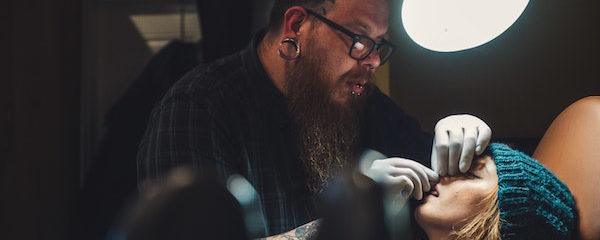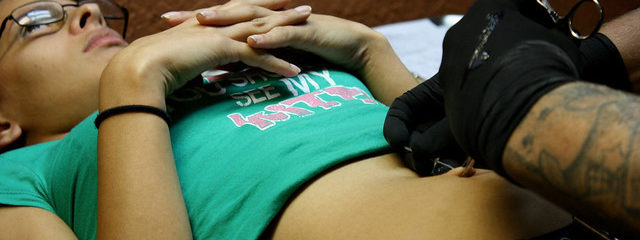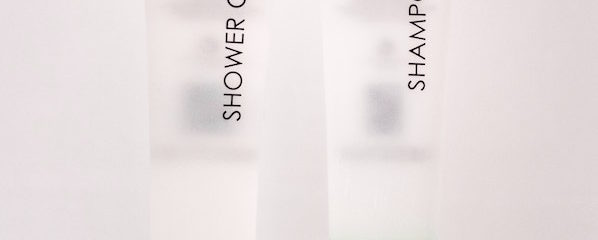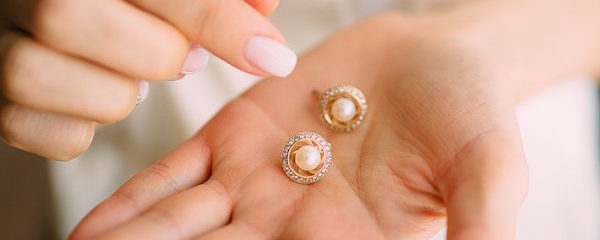Avoiding Piercing Scars: Tips for a Successful Healing Journey May 1, 2019 – Posted in: Informative, Piercing Advice – Tags: advice, aftercare, hypertrophic scarring, keloids, piercing scars
Piercing scars highlights:
- There are two main types of piercing scars: atrophic scars and hypertrophic scars.
- Most scarring can be avoided by keeping your piercing safe from snags and tears, but they may sometimes appear even if you do everything right.
- The best way to get rid of scars is to simply wait. Most scars minimize in appearance over time. If they do not, visit a dermatologist for treatment.
- Every piercing, when removed, will likely leave some kind of mark behind. This should always be a consideration before receiving a piercing.
As much as we wish it were otherwise, there are risks associated with piercings. Scars are among them.
Luckily, preventative measures can be taken to avoid permanent damage. Although scars may appear even if you do everything right, there are a few things that you can do to avoid them, and if one should appear, there are ways to minimize its appearance. A piercing scar won’t leave you disfigured; you’ll just be left with a little mark.
Here’s all you need to know about common piercing scar types and the best ways to avoid them during healing.

Photo by Ozan Çulha
Types of piercing scars
Piercing scars appear due to a number of reasons, including bad snags and tears, piercing migration or rejection, or just bad luck. Some people are more prone to developing scars, and even if you do everything right, they still may appear. It’s simply one of the risks of piercings that you must accept.
Luckily, most scars and marks are very minor. In most cases, a piercing scar isn’t going to leave more of a mark than a chicken pox scar.
However, it’s still beneficial to understand what may be happening to your body and how you might minimize the appearance of piercing scars. Let’s start with some common scar types.
Atrophic scar
Atrophic scars are the most common types of piercing scars. They look like a little pockmark in the skin and occur when your body is unable to regenerate tissue beneath the skin.
Often, atrophic scarring occurs in piercings that have closed up after removing the jewelry. Piercings that have migrated or completely rejected may leave longer, more visible, or slightly discolored atrophic scars in their wake. While you can take measures to reduce the appearance of these scars, such as undergoing a chemical peel or getting fillers, they are likely permanent. The good news is that they are usually quite small.
It’s important to pay attention to your piercing even after it has fully healed. If you see signs of migration or rejection, visit your piercer immediately to discuss your options. Often, your piercing will need to be retired, and the sooner you do this, the less your scarring will be.
Hypertrophic scarring
Hypertrophic scarring occurs when too much collagen is produced during the healing process. A hypertrophic scar appears as slightly raised and bumpy skin around the piercing site. When it’s fresh, it will be pink, but it should turn white over time.
Hypertrophic scarring is considered excessive scarring, and it usually arises due to the prolonged healing time of a piercing compared to a normal wound. It’s caused by an overproduction of collagen, which is why it will appear as a raised mark. Other types of piercing bumps are often misconstrued as hypertrophic scarring, so if you start to see piercing bumps on or around your piercing, don’t panic; it might be another piercing side effect. Visit your piercer or a dermatologist to properly ascertain what your bump might be.
Keloid
A keloid is formed when the body produces far too much collagen, usually after the healing process has completed. It manifests as a large, discolored bump (larger than 4mm) near or on the injured location. A keloid will be firm to the touch and is usually round in shape.
Keloids are something that’s largely misunderstood in the piercing world, and minor piercing bumps or irritation are often misattributed as keloids. They are primarily a genetic issue, and they only affect around 10% of the world’s population, so if you or a family member has never experienced one before, you’re unlikely to develop one. If you do develop a keloid, it will most likely need to be surgically removed; it might decrease in size, but it won’t go away on its own.
The good news is that keloid scarring is much rarer than other scarring types. If you start to see a bump around your piercing, don’t panic; it’s likely something else.
How to Avoid Other Complications During Healing
Scars aren’t the only thing to be aware of as your piercing heals. Other complications include irritation and piercing bumps, both of which are sometimes confused as scarring. To avoid these:
- Get a good start! Make sure your initial piercing is appropriately placed with jewelry that is the correct size, shape, construction, and material.
- Keep other products besides piercing aftercare spray away from your piercing.
- Make sure that you fully dry your piercing after you shower and keep your piercing dry throughout the day.
- See your piercer at the first sign of a bump forming.
NeilMed Piercing Aftercare is just what you need to keep your piercing clean throughout the healing process. Purchase it here.
How do I avoid piercing scars?
A scar can form for a number of reasons. Sometimes, poor aftercare practices are to blame. Other times, it’s simply a matter of genetics. Do yourself a favor and take great care of your piercing while it heals to give it its best chance.
Choose jewelry that’s the proper size
Choosing jewelry that’s the proper size helps keep your piercing safe, and it can prevent your body from rejecting the jewelry. Here are three things to keep in mind when choosing piercing jewelry:
- You must wear jewelry that’s the correct gauge (thickness). If your jewelry is too thin, a bad snag can rip through the skin, and the body might mistake the jewelry as a splinter and try to push it out.
- Your starter jewelry needs to be large enough to leave space for swelling. If the ends of the jewelry press against the new piercing puncture, it risks becoming embedded in the skin.
- Once the swelling has gone down, many piercings require that you switch to a smaller, flusher-fitting piece of jewelry. This will minimize the risk of snags and friction, both of which can cause complications like scars.
Don’t move the jewelry
When you have a new piece of body jewelry in place, it will be tempting to play with it. However, moving the jewelry can cause damage to the surrounding skin.
Be mindful of your new jewelry, and don’t twist or touch it. If you get some crusties around the piercing site that you want to clean, simply soak the piercing in a saline solution and carefully dab the crusties away with a cotton swab or clean paper towel.
Choose a reputable piercer
While scarring is primarily the result of trauma to your piercing rather than misplacement, you must still opt for an experienced piercer to set your piercing up for success.
If your piercer comes out with a piercing gun, run away. Piercing guns use force to push barely sharpened jewelry through the skin, which immediately causes trauma to the piercing area. Especially in the cartilage, piercing guns can contribute to scar formation, so always choose a piercer who uses a needle over a piercing gun.

Photo by Wesley Davi
How to get rid of piercing scars
Even if you do everything right, scars may appear. While they are often permanent, there are ways to minimize their appearance so that you can barely notice them.
Medical treatment
In some cases, scars can only be removed through treatment. A dermatologist may recommend laser therapy, fillers, or other similar treatment options. If you have significant scarring, talk to a doctor to see what they can do.
Scar creams
Over-the-counter creams can help reduce the appearance of scarring. Don’t use scar creams before your piercing has fully healed. They contain chemicals that can irritate healing skin.
Make sure that you use a scar cream that’s safe for your piercing. Before trying any scar cream, be sure to consult a professional. Also, keep in mind that scar creams don’t always work, so be prepared with a plan b.
Compression
In the case of hypertrophic scarring, where the skin appears raised, it’s possible to rub the scar or place pressure on it to break down the collagen and reduce its appearance. However, if your piercing is still healing, this is not a suitable treatment. Moving the jewelry and agitating the healing piercing can cause further issues. Wait until your piercing has healed, then gently rub the scar once a day to help flatten it. You may also use discs to keep pressure on the scar. However, you should not perform this method on your own. Instead, have a professional piercer guide you through this process.
Wait
Most scars fade on their own. Even if they are permanent, they will eventually fade and become barely noticeable. The good thing about piercings is that most of them are small, so the vast majority of piercing scars are minor.
Piercing scars can appear on anyone, even if you do anything right. Before you get your piercing, it’s important to know the risks. At the end of the day, all you can do is make sure that you adhere to your aftercare regimen to greatly reduce the risk of permanent scarring.









